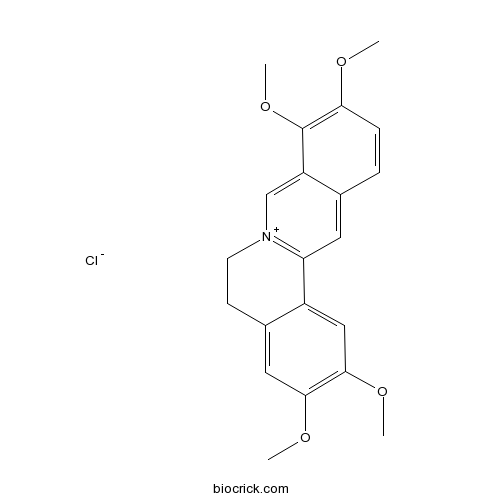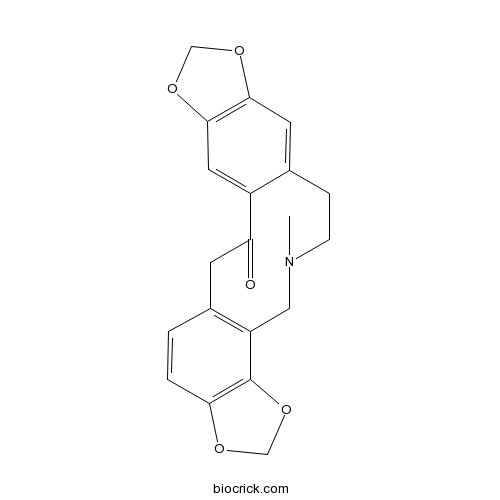Corydalis decumbens
Corydalis decumbens
1. The products in our compound library are selected from thousands of unique natural products; 2. It has the characteristics of diverse structure, diverse sources and wide coverage of activities; 3. Provide information on the activity of products from major journals, patents and research reports around the world, providing theoretical direction and research basis for further research and screening; 4. Free combination according to the type, source, target and disease of natural product; 5. The compound powder is placed in a covered tube and then discharged into a 10 x 10 cryostat; 6. Transport in ice pack or dry ice pack. Please store it at -20 °C as soon as possible after receiving the product, and use it as soon as possible after opening.
Natural products/compounds from Corydalis decumbens
- Cat.No. Product Name CAS Number COA
-
BCN5914
Palmatine hydrochloride10605-02-4
Instructions

-
BCN6165
Protopine130-86-9
Instructions

-
BCN1238
(+)-Bicuculline485-49-4
Instructions

-
BCN4978
Strychnine57-24-9
Instructions

Alkaloids from Corydalis decumbens suppress neuronal excitability in primary cultures of mouse neocortical neurons.[Pubmed: 29571149]
None
Rapid and cost-effective method for the simultaneous quantification of seven alkaloids in Corydalis decumbens by microwave-assisted extraction and capillary electrophoresis.[Pubmed: 28556536]
None
Effects of allocryptopine on outward potassium current and slow delayed rectifier potassium current in rabbit myocardium.[Pubmed: 27403141]
Allocryptopine (ALL) is an effective alkaloid of Corydalis decumbens (Thunb.) Pers. Papaveraceae and has proved to be anti-arrhythmic. The purpose of our study is to investigate the effects of ALL on transmural repolarizing ionic ingredients of outward potassium current (I to) and slow delayed rectifier potassium current (I Ks).
Comparative pharmacokinetics and bioavailability of four alkaloids in different formulations from Corydalis decumbens.[Pubmed: 23773826]
Corydalis decumbens, a Traditional Chinese Medicine listed in Chinese Pharmacopoeia, is clinically used for the treatment of paralytic stroke, headache, rheumatic arthritis and sciatica in China.
Allocryptopine and benzyltetrahydropalmatine block hERG potassium channels expressed in HEK293 cells.[Pubmed: 23524574]
Allocryptopine (ALL) is an alkaloid extracted from Corydalis decumbens (Thunb) Pers. Papaveraceae, whereas benzyltetrahydropalmatine (BTHP) is a derivative of tetrahydropalmatine extracted from Corydalis ambigua (Pall) Cham et Schlecht. The aim of this study was to investigate the effects of ALL and BTHP on the human ether-a-go-go related gene (hERG) current expressed in HEK293 cells.
[Determination of four alkaloids in Corydalis decumbens by HPLC].[Pubmed: 22066451]
To establish a quantitative HPLC method for determination of protopine, palmatine hydrochloride, bicuculline and tetrahydropalmatine, in Corydalis decumbens.
[Simultaneous determination of four alkaloids in Corydalis decumbens (Thunb.) Pers. by high performance liquid chromatography-tandem mass spectrometry].[Pubmed: 21598521]
A method for the analysis of 4 alkaloids in Corydalis decumbens (Thunb.) Pers. was developed by high performance liquid chromatography-electrospray ionization tandem mass spectrometry (HPLC-MS/MS). The sample was extracted in methanol by ultrasonic, filtered and diluted with methanol for further analysis. The analysis was performed on a C18 column (150 mm x 2.1 mm, 3.5 microm) using a gradient elution program with the mobile phase of 0.2% acetic acid solution and acetonitrile. The analyte was determined by an electrospray ionization tandem mass spectrometry in multiple reactions monitoring (MRM) mode. The qualitative and quantitative analyses were based on the retention times and characteristic ion pairs consisting of one parent ion and two fragment ions of the analyte. The limits of detection (LODs) for 4 alkaloids were in the range of 0.02 - 0.2 microg/L, and the limits of quantification (LOQs) were in the range of 0.07 - 0.66 microg/L. The average recoveries were in the range of 93.6% - 103.5% for 4 alkaloids with the relative standard deviations below 3.8%. This method is reliable, sensitive and reproducible, and it can be used for the quality control of Corydalis decumbens (Thunb.) Pers.


